The best way to encounter Sniffen Court is to stumble upon it by accident…which is exactly what I did the other day as I was walking up East 36th Street. From down the street, it’s nearly invisible…
…and then, halfway down the block, you come across this wonderful little alley lined with charming two-story brick residences:
This is Sniffen Court, though “mews” (“A row or street of houses or apartments that have been converted from stables or built to look like former stables”) is probably a more appropriate term:
Sniffen Court doesn’t cut all the way to East 35th Street, making it a very unique byway in Manhattan:
Sniffen Court allegedly got its name from one John Sniffen, who is said to have designed the ten carriage houses lining the court between 1850 and 1860 (these days, the only horses you’ll find on Sniffen are on the outer fence):
But was there even a John Sniffen? In 1991, the NY Times did some digging, and found that the carriage houses were built between 1863 – 1864 by James D. Smith, John E. Wylie, and Caleb B. Knevals – no mention of a Sniffen. In fact, John Sniffen only appears with a connection to the court in a single 1930’s article in the New York Sun, on which all future references are based.
The name remains a mystery.
As the NY Times points out, the off-street placement not only solved noise and odor issues related to horse stables, but the property owners were also able to build 10 units on what would have been approximately five house lots.
The stables were in use until the early 1920s, when automobiles replaced the need for horses and the buildings were converted.
Probably the most famous symbol of Sniffen Court can be seen at the far end: a pair of horseman plaques set into the brick (side note: could that be the only two-halved stable-style front door in Manhattan??):
These were created by sculptor Malvina Hoffman, who lived on Sniffen for more than 40 years. In fact, this is the front wall of her former studio:
Sniffen Court has a connection to rock’n’roll history – the cover of The Doors’ second album Strange Days was shot here in 1967.
After the band had decided on a carnival theme, photographer Joel Brodsky gathered the necessary performers, which included the doorman of the Friar’s Club as the muscleman, and a passing taxi driver paid $5 to play the trumpet. The rear of the album also featured Sniffen:
Sniffen Court even has its own theatrical troupe and performance stage, which are in the two buildings at the northwestern most corner of the alley:
According to a 1959 write-up, The Sniffen Court Players, also known as the Amateur Comedy Club, were founded in April 1884 and are now the oldest amateur theatrical group in the country (over 127 years!). At the time of the piece, the club was about to present their 857th show. I’d love to know if these whimsical designs above the door date back to those early days…
If not, what a great little ornament to the building.
Every once in a while, walking tours are offered of the space, and if anyone has any pictures (or can get me a tour!), I’d love to have a peek. In fact, er, how does this society actually work? Can anyone go to their plays? Or do you have to be a member?
In 1966, Sniffen Court was designated a historical landmark, though several battles have been fought over the years regarding facade changes:
A rare event, two Sniffen properties were put on the market a couple of years ago with asking prices in the few-million-dollar range. Anyone buying #9 not only got a beautiful converted carriage house and private courtyard, but a pretty amazing roof deck to boot:
Number 2 was also recently for sale – love the hanging lantern over the doorway:
What a great window – wish I knew the name for it…
Personally, my favorite buildings are those with design elements harkening back to their stable days…
Really though, Sniffen Court is in such amazing condition that it doesn’t take too much imagination to transport you back to a time when this wonderful bit of Manhattan was reserved simply for the horses:
-SCOUT
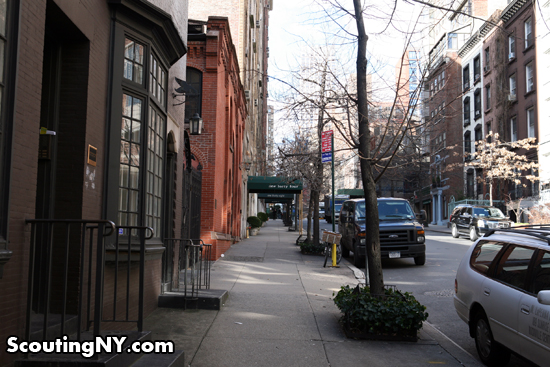
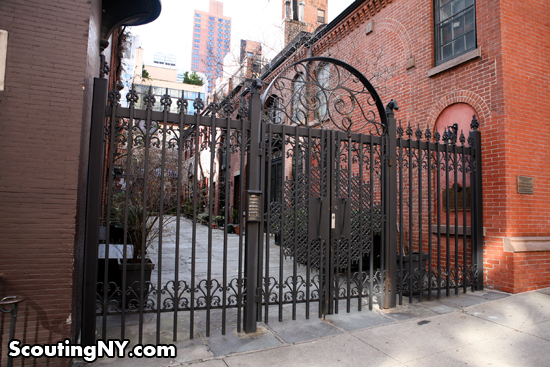
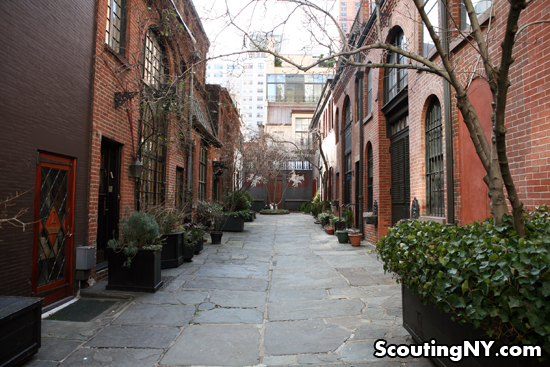

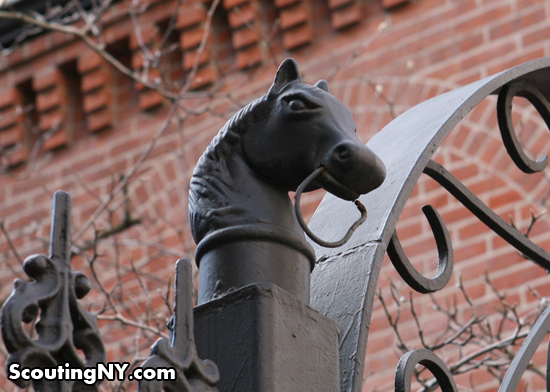



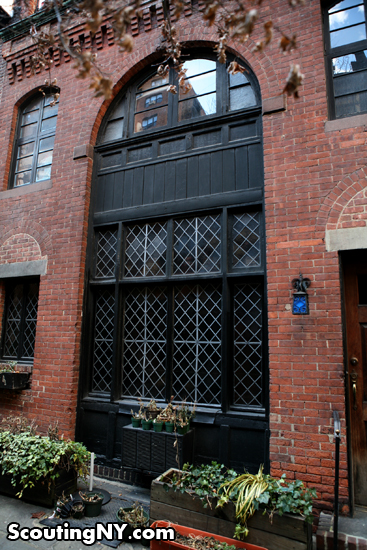

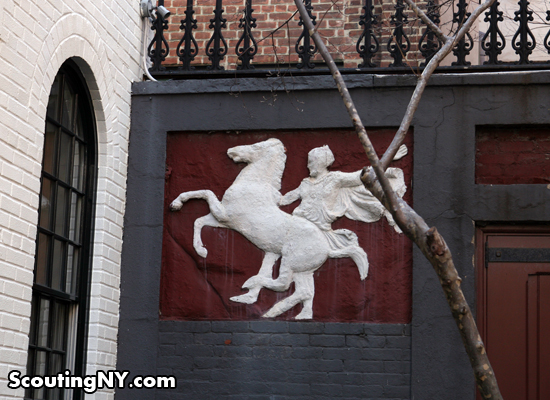


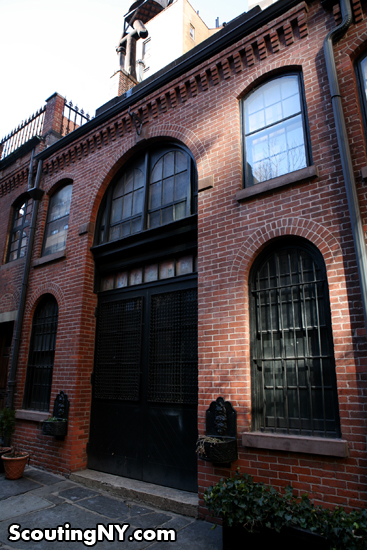


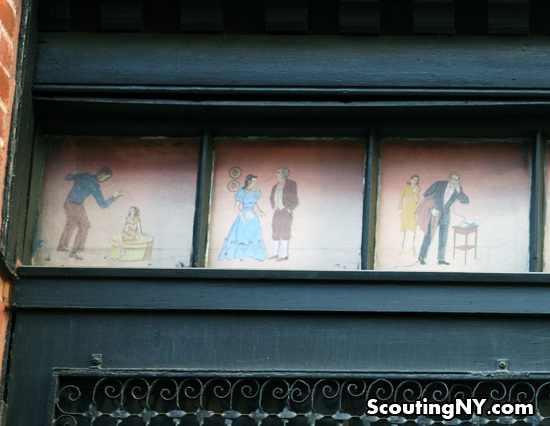


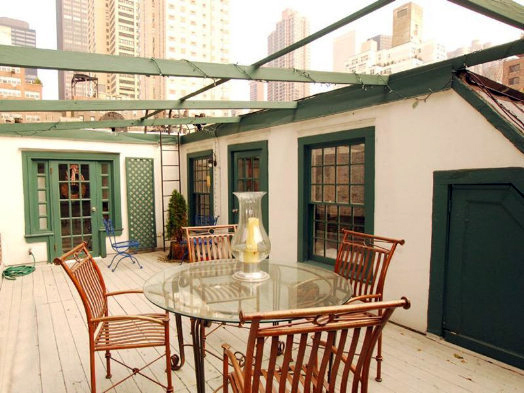






Always loved this spot in NYC. Great pic’s and stories.
I believe it’s called a leadlight or leaded glass window, based on the type of glass.
http://www.tudorartisans.com/glasspage.htm
There’s a very similiar enclave near Gansevoort St, also gorgeous.
Oh, thanks for these pics! I often used to pass by Sniffen Court and would peek in but couldn’t see as much as you’ve shown here. Love this place!
It’s an oriel window…essentially a bay window that projects/overhangs the surface of the building.
Amazing. Such a beautiful place. Thank you for posting. I’m so fascinated by places like these.
Your posts often make my day! 🙂
Still amazed that this still exists in Manhattan!! Beautiful.
Scout, totally sensational. Thanks for sharing this. I so hope you manage to get the information needed to “get inside”. Shall we stay tuned? Wonderful photos as always….
I love these beautiful photos, I had no idea that something like this even existed in New York, I have seen something similar in London, but this was totally unexpected.
Oh, man, I’d completely forgotten about this! I used to pass it all the time when I lived at 34th & 3rd. What gorgeous photos, though, Scout! Especially that next to last one–what I would give for that much window. I need more light in my home life…
Anyone can go see the shows done at the Theatre. You also can become a member of the troupe if you want. Productions there are good.
It’s not quite Abbey Road, but I wonder if any Doors fans get together to try to recreate that album cover? The front would be hard to do but the back would be easy enough.
Rational is incorrect. One must be a guest of a ACC member to attend. In fact, there are no tickets, just a list of member’s invited guests. Also (for clarity) one cannot just “become a member”. They must apply, be interview, hopefully) be accepted, and pay dues.
A very elderly relative recently told me about his first job, as an architect in a studio in Sniffen Court. Circa 1950. Must have been cheap space: It still smelled of horse piss.
One of the more famous residents of Sniffen Ct was just featured in the Times a few months ago:
http://cityroom.blogs.nytimes.com/2011/10/11/a-familiar-figure-begs-on-the-street-but-not-for-himself/
Also has a pic from inside his place.
Th Doors cover is a classic 🙂
I’m reading a book that mentions “Minot Mews”, a similar area in NYC with converted stables. Could this be the same place with a made-up name? The book is “The Joyous Season” by Patrick Dennis.
that’s hands down the funniest book I’ve ever read & I’ve never understood why no one has ever made a movie of it
This is my number 2 most favorite blog now. I came across this 2weeks ago, congratulations, scout.
Bill Cunningham covered this spot with muse/model Editta Sherman during his photo-documentation project of Manhattan’s architectural and fashion history during the late 60s to mid 70s. You can see the photos from this project including the one in Sniffen Court at the NY Historical Society’s Facades exhibit.
http://tmagazine.blogs.nytimes.com/2014/03/13/on-view-a-history-of-new-york-fashion-and-architecture-through-bill-cunninghams-lens/?_php=true&_type=blogs&_r=0
my first apartment in Manhattan as an adult on my own was up the street from sniffin court. At 136 East 36th Street. I walked by everyday and I really don’t remember a gate there. I remember it as being open but this was 1966 so things could have changed easily.I remember the dreaming what it might of been like to live there then and back and time. So many memories!
Hi,
Great post!
I found this after hearing songwriter Dennis Lambert talk about his gig in the 60s at the Sniffen Court tavern. Dennis Lambert wrote “Don’t Pull Your Love”, “One Tin Soldier”, “Ain’t No Woman Like The One I Got” and countless other hits. He did a gig there as a teen and was “discovered” by Peter Grant (who later went on to manage Led Zeppelin). The invited him to the UK where they hooked him up with Freddy and The Dreamers (he wrote “Do The Freddy) and introduced him to Dennis Potter, who would co-write “One Tin Soldier” and go on to be his main writing partner.
Another piece of rock & roll history at Sniffen Court.
I’m glad to know what it looks like. It is featured prominently in one of my favorite children’s books, but living in Southern California, I could never quite visualize it. Thanks for the virtual tour.
The front facing unit is currently for sale. The listing indicates that Cole Porter used to live there!
http://www.corcoran.com/nyc/Listings/Display/3594826?utm_source=criteo&utm_medium=cpc&utm_content=display&utm_campaign=lower_funnel
My great grandfather was an artist and a resident at one point. I have a painting of Sniffen Court that he did.